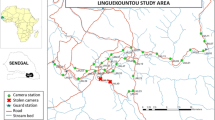Abstract
Monitoring programs are important for effective conservation and management programs. However, most of these programs rely on indirect sign surveys of elusive animals that often leave cryptic signs of their presence. In Sichuan Province, China, sign surveys are oriented mainly toward giant panda (Ailuropoda melanoleuca) populations but also are used to track other nationally listed species. We have developed and tested a monitoring system based on camera-trapping that can detect a wide range of large, terrestrial mammal and bird species within the reserves of Sichuan. This system is embedded within current protected area patrolling activities and relies on a partnership of management agencies, universities and international organizations. The international organizations and national universities primarily provide the training and assist with study design and data analysis. Data management and access is controlled at the regional level by the appropriate state agencies. Limitations to this system include the need for additional training and support to less developed reserves and the long-term availability of funds to support field staff. However, the potential return on investment is a consistent tracking of multiple species across diverse set of reserves, facilitating comparative analysis of results that will assist in adaptive management throughout the region.

Similar content being viewed by others
References
Azlan JM, Sharma DSK (2006) The diversity and activity patterns of wild felids in a secondary forest in Peninsular Malaysia. Oryx 40:36–41
Carbone E, Christie S, Conforti K et al (2001) The use of photographic rates to estimate densities of tigers and other cryptic mammals. Anim Conserv 4:75–79
Caro TM, O’Doherty G (1999) On the use of surrogate species in conservation biology. Conserv Biol 13:805–814
Cutler TL, Swann DE (1999) Using remote photography in wildlife ecology: a review. Wildl Soc B 27:571–581
Dahmer TD, Gui X, Tian S (2004) Camera-trapping to determine the status of South China Tiger in Hupingshan National Nature Reserve, Hunan Province. In: Proceeding of the XIXTH International Congress of Zoology, China Zoological Society, Beijing, China
Datta A, Anand MO, Naniwadekar R (2008) Empty forests: large carnivore and prey abundance in Namdapha National Park, north-east India. Biol Conserv 141:1429–1435
Foster ML, Humphrey SR (1995) Use of highway underpasses by Florida panthers and other wildlife. Wildl Soc B 23:95–100
Gu XD, Yang ZS, Wang G (2004) Status analysis of eco-monitoring in giant panda nature reserves, Sichuan. Sichuan J Zool 23:146–148
Gu XD, Wang HJ, Liu FW (2005) Biodiversity monitoring in giant panda nature reserves in Minshan Mountain Region. Sichuan J Zool 24:168–170
Hines JE (2006) PRESENCE v2.2—software to estimate patch occupancy and related parameters. USGS-PWRC. http://www.mbr-pwrc.usgs.gov/software/PRESENCE.html. Accessed 25 Nov 2008
Hu JC (ed) (2005) A report of the comprehensive survey on Tangjiahe Nature Reserve in Sichuan, China. Sichuan Science and Technical Press, Chengdu
Jennelle CS, Runge MC, MacKenzie DI (2002) The use of photographic rates to estimate densities of tigers and other cryptic mammals: a comment on misleading conclusions. Anim Conserv 5:119–120
Karanth KU (1995) Estimating tiger Pathera tigris populations from camera-trap data using capture-recapture models. Biol Conserv 71:333–338
Karanth KU, Nichols JD (1998) Estimation of tiger densities in India using photographic captures and recaptures. Ecology 79:2852–2862
Loucks CJ, Lu Z, Dinerstein E et al (2001) Giant pandas in a changing landscape. Science 294:1465
Lu Z, Pan WS, Zhu XJ (2000) What has the panda taught us? In: Entwistl A, Dunstone N et al (eds) Priorities for the conservation of mammalian diversity. Cambridge University Press, Cambridge, UK, pp 325–334
Lu XL, Jiang ZG, Tang JR et al (2005) Auto-trigger camera traps for studying giant panda and its sympatric wildlife species. Acta Zool Sin 51:495–500
Ma M, Xu F, Chundawat RS et al (2006) Camera trapping of snow leopards for the photo capture rate and population size in the Muzat Valley of Tianshan Mountains. Acta Zool Sin 52:788–793
MacKenzie DI, Nichols JD, Lachman GB et al (2002) Estimating site occupancy rates when detection probabilities are less than one. Ecology 83:2248–2255
MacKenzie DI, Nichols JD, Hines JE et al (2003) Estimating site occupancy, colonization, and local extinction when a species is detected imperfectly. Ecology 84:2200–2207
MacKenzie DI, Nichols JD, Royle JA et al (2006) Occupancy estimation and modeling. Academic Press, New York
Marsh DM, Trenham PC (2008) Current trends in plant and animal population monitoring. Conserv Biol 22:647–655
McShea WJ, Stewart C, Peterson L et al (2009) The importance of secondary forest blocks for terrestrial mammals within an Acacia/secondary forest matrix in Sarawak, Malaysia. Biol Conserv 142:3108–3119
Morrison JC, Sechrest W, Dinerstein E et al (2007) Persistence of large mammal faunas as indicators of global human impacts. J Mammal 88:1363–1380
O’Brien TG, Kinnaird MF, Wibisono HT (2003) Crouching tigers, hidden prey: Sumatran tiger and prey populations in a tropical forest landscape. Anim Conserv 6:131–139
O’Brien TG, Baillie JEM, Krueger L, Cuke M (2010) The Wildlife Picture Index: monitoring top trophic levels. Anim Conserv. doi:10.1111/j.1469-1795.2010.00357.x
Pei JQ (1998) An evaluation of using auto-trigger cameras to record activity patterns of wild animals. Taiwan J For Sci 13:317–324
Pereira HM, Cooper HD (2006) Towards the global monitoring of biodiversity change. Trends Ecol Evol 21:123–129
Rowcliffe JM, Field J, Turvey ST et al (2008) Estimating animal density using camera traps without the need for individual recognition. J Appl Ecol 45:1228–1236
Schaller GB (1994) The last panda. University of Chicago Press, Chicago
Schaller GB, Hu JC, Pan WS et al (1985) The giant panda of Wolong. University of Chicago Press, Chicago
Sheil D (2001) Conservation and biodiversity monitoring in the tropics: realities, priorities, and distractions. Conserv Biol 15:1179–1182
Sichuan Forestry Department [SFD] (2001) Master plan for wild fauna and flora conservation and nature reserve construction project in Sichuan province. Sichuan Forestry Department, Chengdu, China
Sichuan Forestry Department [SFD] (2002) Report of the third giant panda national census in Sichuan province. Sichuan Field Survey Team for the Third National Giant Panda Census, Chengdu
Sichuan Forestry Department [SFD] (2003) Biodiversity monitoring protocol for giant panda nature reserves of Sichuan Province. Sichuan Forestry Department, Chengdu, China
Silveira L, Jacomo ATA, Diniz-Filho JAF (2003) Camera trap, line transect census and track surveys: a comparative evaluation. Biol Conserv 114:351–355
State Forestry Administration [SFA] (2006) The 3rd national survey report on giant panda in China. Science Press, Beijing
Swann DE, Hass CC, Dalton DC et al (2004) Infrared-triggered cameras for detecting wildlife: an evaluation and review. Wildl Soc B 32:357–365
Tilson R, Hu DF, Jeff M et al (2004) Dramatic decline of wild South China tigers: field survey of priority tiger reserves. Oryx 38:40–47
Tobler MW, Carrillo-Percastegui SE, Pitman RL et al (2008) Further notes on the analysis of mammal inventory data collected with camera traps. Anim Conserv 11:187–189
Wang DJ, Li S, McShea WJ et al (2006) Use of remote-trip cameras for wildlife surveys and evaluating the effectiveness of conservation activities at a nature reserve in Sichuan Province, China. Environ Manag 38:942–951
Wanglang Nature Reserve Administration (WNRA) (1998) Wanglang Nature Reserve baseline survey report. Wanglang Nature Reserve, Pingwu, Sichuan, China
Whitefield J (1998) A saola poses for the camera. Nature 396:410
Wildlife Conservation Society (WCS) (2002) First photo of wild Siberian Tiger in China. http://www.wcs.org/tigerimage. Accessed 15 Jan 2008
Xie Y (2004) Review on the management system of China’s nature reserves. In: Xie Y, Wang S, Peter S (eds) China’s protected areas. Tsinghua University Press, Beijing, pp 33–49
Acknowledgments
This project was supported by Smithsonian’s National Zoological Park, Friends of the National Zoo, Peking University, Sichuan Forestry Department, China Wildlife Conservation Association, and World Wildlife Fund China. We thank Tangjiahe NR and Wolong NR for hosting the training courses and workshops, and all the reserve staffs that assisted with program management, data collection and logistic support. We also thank George B. Schaller and Colby Loucks for reviewing our manuscript and providing valuable comments. We had fruitful discussions with Lu Zhi, Wang Hongjia, Gu Haijun and Dai Bo on this project and the manuscript.
Author information
Authors and Affiliations
Corresponding author
Rights and permissions
About this article
Cite this article
Li, S., Wang, D., Gu, X. et al. Beyond pandas, the need for a standardized monitoring protocol for large mammals in Chinese nature reserves. Biodivers Conserv 19, 3195–3206 (2010). https://doi.org/10.1007/s10531-010-9886-x
Received:
Accepted:
Published:
Issue Date:
DOI: https://doi.org/10.1007/s10531-010-9886-x




